How to Freeze Macarons
To freeze macarons, start by allowing them to cool completely on a parchment-lined baking sheet. Flash freeze them by placing the sheet in the freezer for 1-2 hours. Then, transfer the macarons to an airtight container or freezer bag, separating layers with parchment paper. For filled macarons, let them mature in the fridge for 24 hours before freezing. Unfilled shells can last up to 2 months in the freezer, while filled macarons typically last 1-2 months. When you're ready to enjoy, thaw them in the refrigerator for a few hours or at room temperature for 20-30 minutes. Proper storage techniques guarantee your macarons maintain their delicate texture and flavor. Discover more tips to perfect your macaron preservation process.
This post may contain affiliate links. If you make a purchase through these links, I may earn a commission at no additional cost to you. Additionally, portions of this post may be generated using artificial intelligence (AI) technology. While we strive for accuracy, please be aware that AI-generated content may not always be perfect and should be fact-checked when necessary.
The Spatula Scoops
- Allow macaron shells to cool completely before freezing to prevent condensation and texture changes.
- Flash freeze macarons on a parchment-lined baking sheet for 1-2 hours before transferring to airtight containers.
- Separate layers of macarons with parchment paper to prevent sticking and maintain shape during storage.
- Freeze unfilled shells for up to 2 months, or filled macarons for 1-2 months, depending on the filling type.
- Thaw frozen macarons in the refrigerator or at room temperature, and consume within a week for best quality.
Preparing Macarons for Freezing
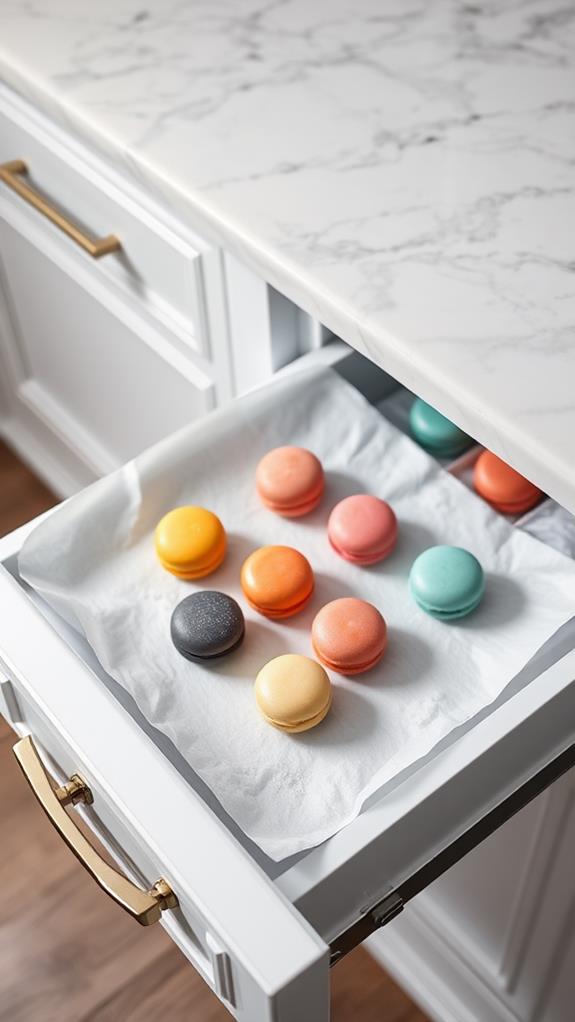
When preparing macarons for freezing, it's crucial to start with completely cooled shells. After baking, allow your macaron shells to cool entirely on the parchment-lined baking sheet. Once cooled, wrap the baking sheet in plastic wrap before transferring it to the freezer. This initial step helps preserve the delicate texture of your macarons. For precise portioning, consider using silicone freezer trays with convenient fill lines to freeze individual macaron shells or assembled macarons.
Freeze the shells on the baking sheet for up to an hour. After this initial freeze, you'll want to transfer them to an airtight container for long-term storage. This two-step process helps prevent cracking or damage to your macaron shells.
Consider your fillings when preparing macarons for freezing. If you're using fillings that freeze well, like buttercream, you can assemble your macarons before freezing. However, if you're using fillings that don't freeze well, such as jellies, it's best to freeze only the shells.
For fully assembled macarons, allow them to mature in an airtight container for 12 to 24 hours before freezing. This maturation process enhances their flavor and texture. By following these steps, you'll extend the shelf life of your macarons and preserve their quality for future enjoyment.
Proper Freezing Techniques
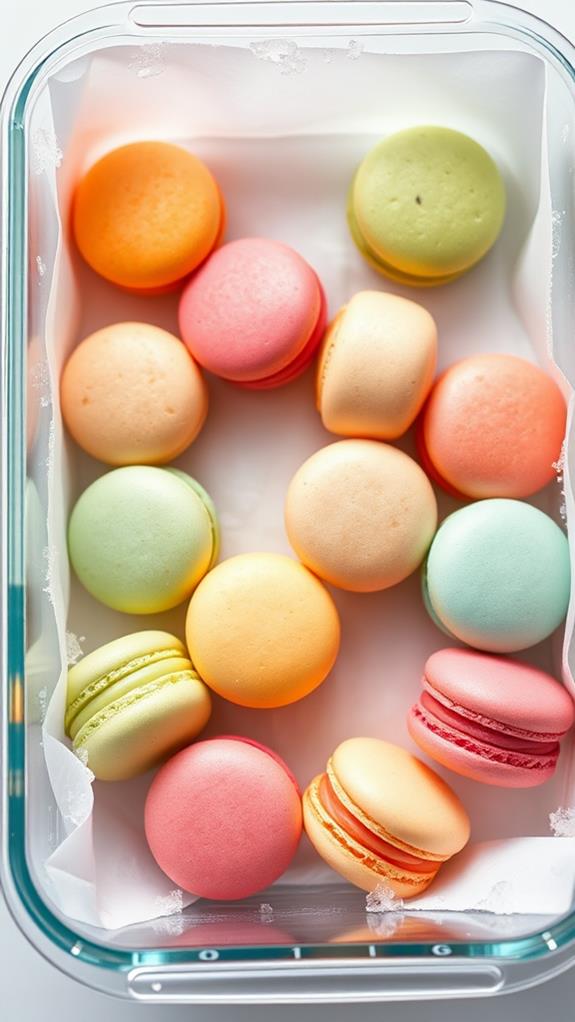
You'll want to start with the flash freezing method to prevent your macarons from sticking together. Place your macaron shells or assembled macarons on a baking sheet lined with parchment paper, and freeze them for about an hour before transferring them to an airtight container. For ideal storage, consider using silicone freezer molds with tight-fitting lids to protect your macarons from freezer burn and maintain their delicate texture. Once flash-frozen, carefully stack the macarons in the container, separating layers with parchment paper to maintain their shape and texture during long-term freezing.
Flash Freezing Method
To properly freeze macarons, the flash freezing method stands out as an effective technique. This process involves rapidly freezing the macaron shells to preserve their texture and prevent freezer burn. You'll need to arrange your macarons in a single layer on a baking sheet lined with parchment paper. Place the sheet in the freezer for about 1-2 hours, ensuring the macarons don't touch each other.
Once they're frozen solid, you can transfer them to an airtight container or freezer bag. This method helps maintain the quality of your macarons for longer periods. Here's a quick comparison of flash freezing vs. regular freezing:
| Aspect | Flash Freezing | Regular Freezing |
|---|---|---|
| Speed | Rapid (1-2 hours) | Slow (4-6 hours) |
| Texture | Preserved | May become soggy |
| Freezer Burn | Minimized | More likely |
| Space Efficiency | Initially less | More efficient |
Airtight Container Storage
Proper airtight container storage is essential for maintaining your macarons' quality during freezing. Once you've flash-frozen your macaron shells, it's time to transfer them to a suitable container for long-term storage. Choose an airtight container, such as a plastic container with a secure lid or a freezer-safe resealable bag, to protect your macarons from freezer burn and moisture loss.
Before storing your macarons, arrange the shells in a single layer on a baking sheet and freeze them for at least two hours. This step prevents the shells from sticking together when you freeze macaron batches in bulk. After this initial freeze, carefully transfer the shells to your chosen container. To further safeguard your macarons, remove as much air as possible from the container before sealing it. This extra precaution helps protect against freezer burn, ensuring your macarons maintain their delicate texture and flavor.
Don't forget to label your container with the date and contents. This simple step helps you keep track of your macarons' age and prevents overcrowding in your freezer. When storing macarons properly, they can last up to two months in the freezer without compromising their quality.
Choosing the Right Storage Container
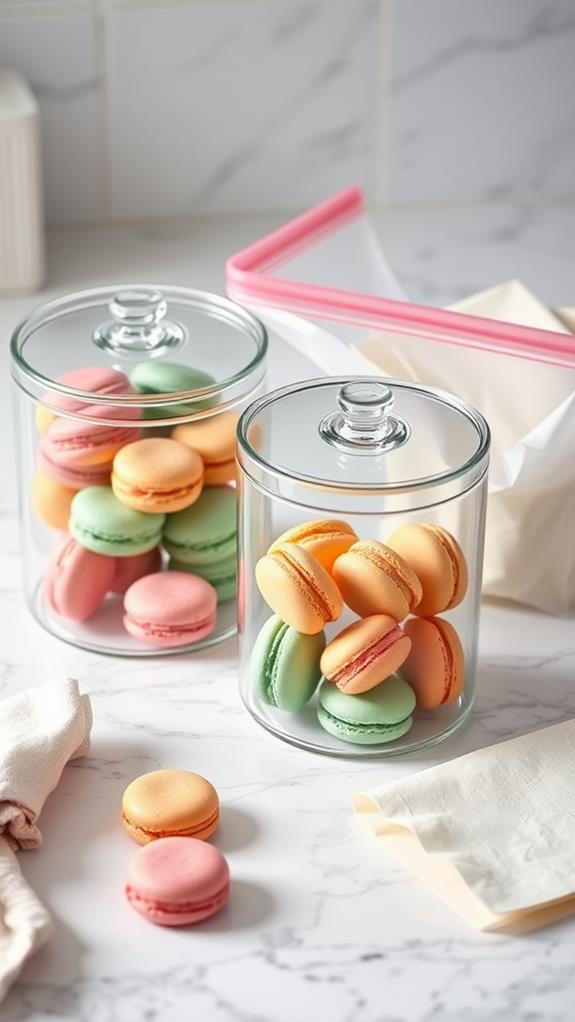
Selecting an appropriate storage container is essential for successfully freezing macarons. When you're preparing your delicate treats for Long-Term Storage, you'll want to choose a container that offers maximum protection. Airtight containers are your best bet, as they prevent freezer burn and maintain freshness. While you might be tempted to simply wrap your macarons in plastic wrap, this won't provide adequate protection for frozen storage.
For ideal results, opt for rigid plastic containers or glass jars with tight-fitting lids. These options not only create an airtight seal but also help maintain the macaron's shape during the freezing process. If you're using a plastic container, make sure it's sturdy enough to withstand the cold temperatures without becoming brittle. Airtight glass jars with wide mouths are particularly useful for storing macarons, as they provide easy access and excellent protection against moisture and odors.
To keep your macarons from sticking together, layer them with parchment or wax paper. This step is pivotal, especially if you're planning to freeze macarons in large batches. Don't forget to label your container with the date and flavor – this will help you keep track of your frozen treats and confirm you use them within the recommended timeframe. While macarons in the fridge have a shorter shelf life, properly frozen macarons can last for months.
Freezing Filled Vs Unfilled Macarons
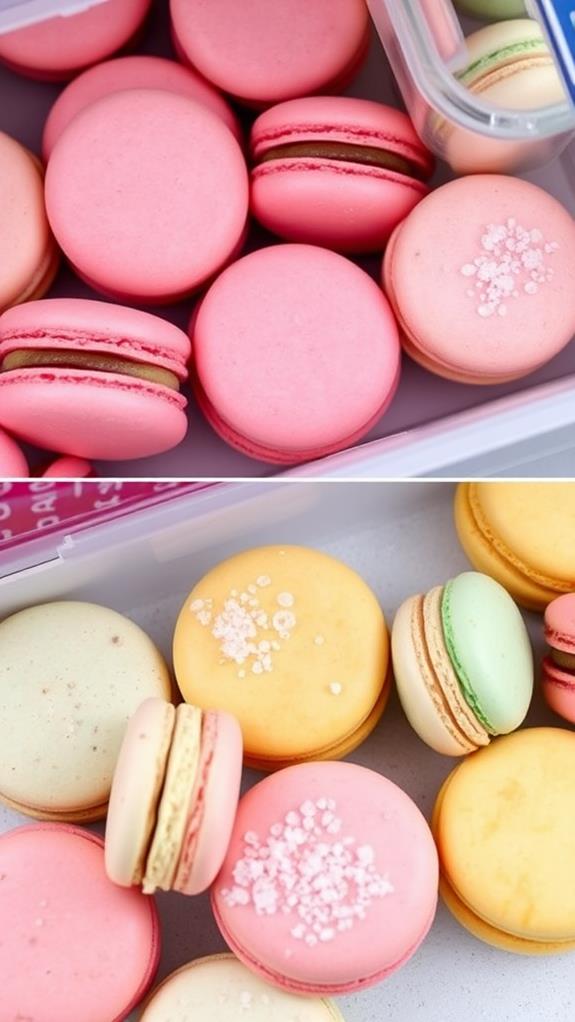
When it comes to freezing macarons, you'll find that unfilled shells generally have a longer shelf life in the freezer. You can store unfilled macaron shells for up to 2 months, giving you more flexibility in your baking schedule. If you're freezing filled macarons, you'll need to contemplate the maturation process, allowing them to rest in the fridge for 24 hours before freezing to guarantee the best texture and flavor once thawed.
Unfilled: Longer Shelf Life
Why choose to freeze unfilled macaron shells? The answer lies in their impressive shelf life and versatility. Unfilled macaron shells can be frozen for up to two months, giving you ample time to plan and prepare for special occasions or bulk baking sessions. This extended freezer life makes them an ideal option when you want to make them ahead of time.
Unlike fully assembled macarons, which are more susceptible to texture changes and sogginess when frozen, unfilled shells maintain their crisp exterior and chewy interior remarkably well. This preservation of quality allows you to create fresh-tasting macarons on demand, even weeks after you've baked the shells. When you're ready to serve, simply thaw the shells and fill them with your chosen filling.
This method also offers greater flexibility in flavor combinations. You can make a large batch of plain shells and experiment with different fillings as needed, rather than committing to one flavor for an entire batch. By freezing unfilled shells, you're fundamentally creating a convenient macaron "bank" that you can draw from whenever the craving strikes or unexpected guests arrive.
Filled: Maturation Considerations
While freezing unfilled macaron shells offers flexibility, you might prefer to freeze filled macarons for convenience. However, it's imperative to let them mature before freezing. After filling your macarons, let them cool and come to room temperature. Then, store them in the refrigerator for 12-24 hours. This maturation period allows the filling to set and stabilize, preventing soggy shells when thawed.
Not all fillings freeze equally well. Solid fillings like ganache, buttercream, and even marshmallow are freezer-friendly. However, wet fillings may compromise the macaron's quality if frozen for too long. For best results, freeze macarons with stable fillings and consume them within a month.
When you're ready to enjoy your frozen macarons, let them thaw in the refrigerator. Once they've reached the desired temperature, you'll have about a week to savor them at their best. Remember, as macarons mature, their flavors meld and intensify, so the freezing process can actually enhance their taste. By following these guidelines, you'll guarantee your filled macarons maintain their delightful texture and flavor, even after freezing.
Thawing Frozen Macarons
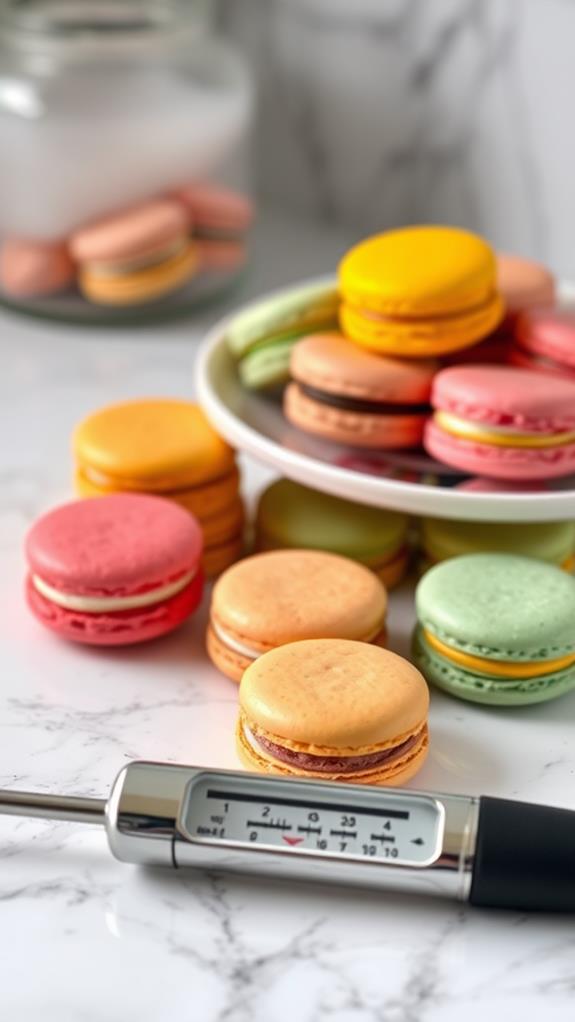
Properly thawing frozen macarons is pivotal to maintaining their delicate texture and flavor. When you're ready to enjoy your frozen macarons, you'll need to allow them time to thaw and stay fresh. While filled macarons need time to mature, frozen macarons require a different approach to guarantee ideal taste and texture.
You've got two main options for thawing your macarons. First, you can let them sit at room temperature for 20-30 minutes. This method works well if you're in a hurry and want to soften the buttercream filling quickly. Alternatively, you can thaw them in the refrigerator for a few hours. This slower method helps prevent condensation on the shells, which can affect their texture.
For an extra touch, you can gently warm the thawed macarons in a 200°F oven for 2-3 minutes. This will further soften the filling, enhancing their overall texture. Remember, once you've thawed your macarons, don't refreeze them. This can negatively impact their quality and texture. Consume thawed macarons within a week for the best taste and shelf life.
Shelf Life in the Freezer
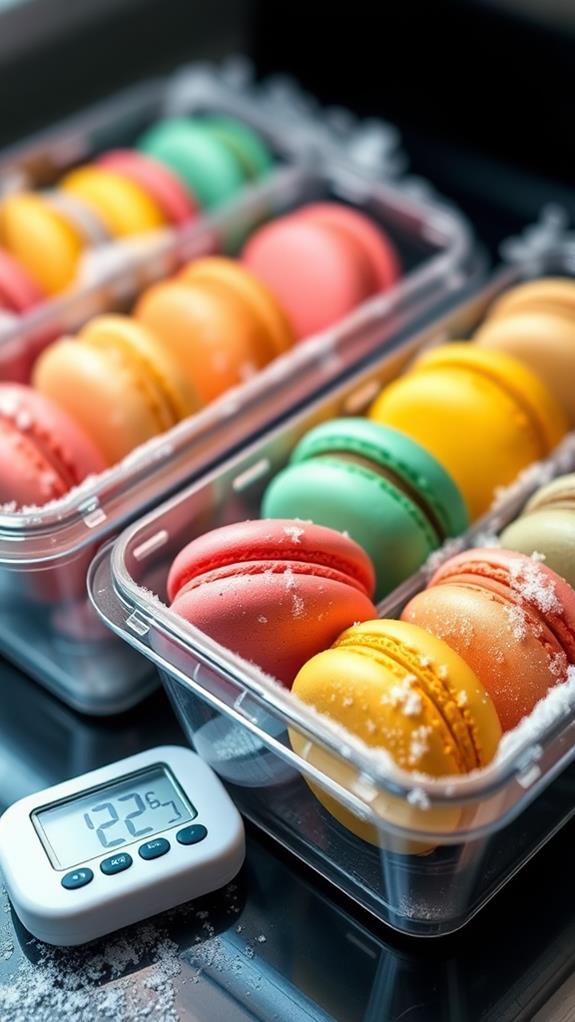
Macarons' shelf life in the freezer depends on whether they're filled or unfilled. Unfilled macaron shells can be frozen for up to 2 months, giving you plenty of time to prepare them in advance. When storing these shells, use parchment paper between layers to prevent sticking and damage.
Filled macarons stay fresh in the freezer for varying lengths of time, depending on the filling. Those with solid fillings like ganache or buttercream can be frozen for 1 to 2 months. Macarons with marshmallow filling also freeze well. However, if you've used wet fillings, your macarons may last less than a month in the freezer before becoming soggy.
It's important to note that once you've thawed your frozen macarons, you should consume them within a week for the best taste and texture. This applies to both filled and unfilled macarons. To maximize their shelf life, store your macarons in airtight containers and avoid frequent temperature fluctuations. By following these guidelines, you can enjoy your homemade or store-bought macarons for an extended period, ensuring you always have these delightful treats on hand.
Tips for Maintaining Quality
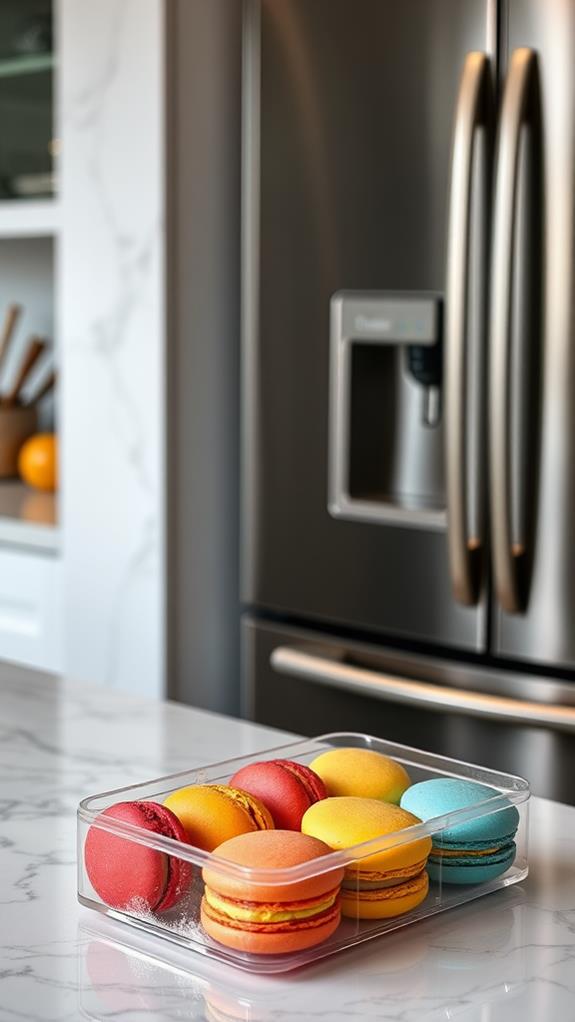
To maintain the quality of your frozen macarons, you'll need to pay attention to a few key details. Proper storage is indispensable, so use air-tight containers to prevent moisture from affecting your delicate treats. Remember, the shells can stay fresh longer when stored separately from fillings.
When freezing macarons, ensure they're completely cooled to avoid condensation issues. This step is vital, as moisture can compromise the texture and appearance of your macarons. Most decorations, including fondant and shimmer powder, freeze well, but be cautious with royal icing as it may run during thawing.
Keep in mind that macaron quality starts to decline after one month in the freezer, though some sources suggest they can last up to three months. To optimize your macarons' shelf life, consider labeling your containers with the date of freezing. This practice helps you track freshness and guarantees you use them before quality deteriorates.
When commenting on blogs about freezing macarons, note that required fields are marked, and your comment data may be processed by Akismet to reduce spam. Some posts may contain affiliate links, so be aware of this when seeking additional information on macaron storage techniques.
Frequently Asked Questions
What Is the Best Way to Freeze Macarons?
To freeze macarons effectively, you'll want to contemplate two options. For unfilled shells, cool them completely, wrap them securely, and freeze for up to two months. If you're freezing filled macarons, let them mature in the fridge for 24 hours first. Then, place them in an airtight container and freeze for 1-2 months. Remember, macarons with wet fillings may not last as long. Always thaw frozen macarons in the refrigerator and consume within a week of defrosting.
What Is the Best Way to Store Macarons?
To store macarons properly, you'll want to keep them in an airtight container. For unfilled shells, refrigerate them for up to 5 days. If they're filled, they'll last about 3 days in the fridge. Buttercream or ganache-filled macarons can stay fresh for up to 5 days, while those with caramel or liquid fillings should be eaten within 2-3 days. Always protect your macarons from humidity and moisture to maintain their delicate texture. For longer storage, you can freeze them for 1-2 months.
How Long to Thaw Frozen Macarons?
Did you know that 90% of macaron enthusiasts prefer room temperature macarons? To thaw frozen macarons, you'll want to let them sit at room temperature for 20-30 minutes. If you've got macarons with solid fillings like ganache or buttercream, you can serve them directly from the freezer. For those with delicate or wet fillings, give them 30-40 minutes to prevent sogginess. Remember, gradual thawing preserves texture and flavor, so avoid using the microwave or oven.
Do Macaroon Cookies Freeze Well?
Macaroon cookies freeze well, but it's important to distinguish between macaroons and macarons. Macaroons, the coconut-based cookies, freeze excellently. You can store them in an airtight container for up to 3 months. When you're ready to eat them, simply thaw them at room temperature for about 30 minutes. They'll retain their chewy texture and coconut flavor. Remember to separate layers with parchment paper to prevent sticking. For best results, consume your thawed macaroons within a week.
Conclusion
You've now mastered the art of freezing macarons. Remember, proper preparation and storage are key to maintaining their delicate texture and flavor. Whether you're freezing filled or unfilled macarons, choose the right container and follow the thawing process carefully. With these techniques, you'll be able to enjoy your homemade macarons long after you've baked them. Just don't expect them to last as long as a Nokia 3310 in your freezer—they're not indestructible! Always prioritize quality and freshness for the best macaron experience.





